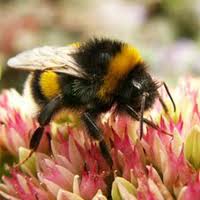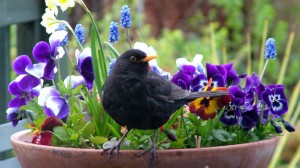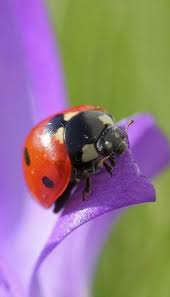





The most important part of good gardening methods, is to encourage all forms of life in the soil and the environment. The more wildlife there is in the garden, the more plant life it can support. More plant diversity encourages more wildlife, which then eats the pests for you. The greater the range of plants the more cycles of life we can squeeze in.
 If there is little life in the soil there will be fewer forms of wildlife in the garden. Why stay where there is nothing to eat? The multitude of insect and scurrying life forms are increased by growing many diverse plants providing food, water, shelter, nesting and wintering sites. Larger forms of life are thus enticed into your garden with yet more plants.
If there is little life in the soil there will be fewer forms of wildlife in the garden. Why stay where there is nothing to eat? The multitude of insect and scurrying life forms are increased by growing many diverse plants providing food, water, shelter, nesting and wintering sites. Larger forms of life are thus enticed into your garden with yet more plants.
However, a well-planned garden is not just filled with plants that benefit wildlife, but every nook and cranny is packed with nest boxes for birds of all sizes, bat roosts, hedgehog dens, frog and toad pits, piles of rotting logs in shady corners, beetle zones and ladybird nests. Of course more pests are supported in the average garden than would be there in the wild because of the diversity of food sources. The balance point they reach is not necessarily one that suits us, so we try to move it in our favour by aiding the beneficial creatures. In an organic garden there are larger populations of predators and parasites to keep them all in check.
Although we may recognise a legal boundary at the end of our garden, nature does not; so unless we glass in our property we cannot absolutely control which forms of wildlife we have. But we can encourage the beneficial kinds by offering the habitats they prefer, and the more we gather into our garden the more it will throb with life. This contradicts the conventional view that almost every creature needs instant annihilation. The mix of inhabitants in a healthy garden is amazingly varied, from the larger creatures down to countless varieties of bacteria, fungi and other forms of microlife, most of which are beneficial, especially the nitrogen-fixing bacteria such as Rhizobium, Clostridium and Azotobacter, and fungi such as Penicillium and Trichoderma. All of these preying on each other, the plants and all the breakdown products in between, yet all powered in the end by photosynthesis fixing the sun.

Image source: www.bbc.co.uk/nature
We can categorise all these forms of life as pests, predators, pollinators, recyclers and so on, but in reality they are all indivisible parts of nature’s cycle of life. Each creature plays many parts interacting with other creatures and plants. For example, butterflies were once caterpillars eating leaves; blackbirds may be pests when they are scratching mulch on to the lawn or eating fruit, but are predators when eating wireworms or leather jackets. Such creatures are continually recycling living and dead material. The value of all this fertility is easily the daily equivalent of several handfuls of organic fertiliser, distributed unseen and unnoticed in a healthy garden where the material is quickly incorporated by the soil life. Our aim, as organic gardeners, is to get as many chains of life going as possible, attracting wildlife of all forms to our garden for the hidden fertility they bring with them and the checks and balances that come from building up the natural populations.
Wildlife control and encouragement: aiding nature’s ecosystems In order to maximise the number and variety of forms of life in the garden we must provide for their needs. All creatures exist in their natural habitat. If a niche exists, they will move into it. It is up to us to offer as varied and dense a planting as we can without choking the plants, and under and within this to provide shelter and refuges for the creatures to escape from our tidying, or to overwinter. Within each garden we can create damp corners, warm dry spots and shady overgrown areas, avoiding over-cleanliness and uniform tidiness. Nests of dry twiggy material for small creatures can be hidden in every evergreen and bundles of hollow stems pushed under fences and sheds. Even a strip of long grass beside a hedge or along a fence is a surprisingly good habitat and will soon be found to be full of beetles, spiders and other predators — add bulbs for spring interest and you introduce pollen and nectar into the bargain, doubling the value of the scheme. Installing nest boxes for birds and hedgehogs is a very effective method of increasing their numbers. We can supplement the food supply to this recycling system by adding organic material and natural fertiliser to the soil, and letting the leaves of autumn and the fallen petals return to the earth to feed the wildlife.
 All these creatures need water, so make it as accessible and in as many places as possible. Indeed, water will lure and retain more difficult forms of life than any other attraction. Birdbaths, waterfalls, fountains, a deep pond, a shallow pool, a muddy stagnant ditch, even just a buried sink will all appeal to different creatures. Even jam jars or plastic pots can play a useful role in providing water for small animals and birds — though they can equally be death traps if no egress is allowed for. Especially useful are plants such as teasel which have cupped stem/leaf joints that trap a little pool of water.
All these creatures need water, so make it as accessible and in as many places as possible. Indeed, water will lure and retain more difficult forms of life than any other attraction. Birdbaths, waterfalls, fountains, a deep pond, a shallow pool, a muddy stagnant ditch, even just a buried sink will all appeal to different creatures. Even jam jars or plastic pots can play a useful role in providing water for small animals and birds — though they can equally be death traps if no egress is allowed for. Especially useful are plants such as teasel which have cupped stem/leaf joints that trap a little pool of water.
Sadly the natural breeding places for frogs, toads, newts and other water-loving creatures are in rapid decline. Farm ponds have been filled in, ditches scraped clean or replaced with pipes, and marshlands drained. So it is up to us to provide alternatives. Fortunately, this is easy to do. Garden pools probably account for the majority of breeding sites, and an old bath, dug in and camouflaged, makes an excellent small pool at no cost. Do remember, however, to make an easy way out for small creatures by placing a piece of rough wood dipping in at the edge of the pool.
Copyright © www.100flowers.win Botanic Garden All Rights Reserved